Dr. Edward G. Dyer
THE LIFE AND TIMES OF DR. EDWARD G. DYER
One of Burlington's earliest settlers and one of its most distinguished and admired citizens was Dr. Edward Galusha Dyer. Dr. Dyer first came to Foxville, as Burlington was then known, in the fall of 1836, leaving his wife and child in Ohio. He made 3 or 4 land claims; helped his brother-in-law, Origen Perkins, mud up a log house; split rails for a fence on a claim his father had made the summer before; and arranged for a little log house to be put up on his father's claim.
After about 5 weeks in what was then mostly wilderness, Dr. Dyer rejoined his family at Richmond, Ohio, where, in addition to being a doctor, he was also postmaster.
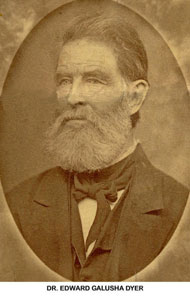
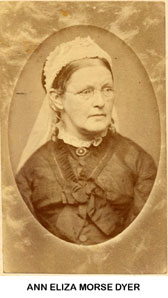 Dr. Dyer (left) had been born on a farm in Russia, Herkimer County, New York, in 1806, the second of Charles and Mary Galusha Dyer's 11 children, 4 of whom did not survive childhood. After receiving his degree from Fairfield Medical College in New York, he began his practice in Trenton, New York, in 1830. A few months later, however, he moved 50 miles west, to Kirkville. The next year, he married Ann Eliza Morse (right), of Trenton. He and Eliza had four children: Charles, born in New York in 1834; William and Emily, born in Ohio in 1837 and 1839; and Harriet, born in Burlington in 1846.
Dr. Dyer (left) had been born on a farm in Russia, Herkimer County, New York, in 1806, the second of Charles and Mary Galusha Dyer's 11 children, 4 of whom did not survive childhood. After receiving his degree from Fairfield Medical College in New York, he began his practice in Trenton, New York, in 1830. A few months later, however, he moved 50 miles west, to Kirkville. The next year, he married Ann Eliza Morse (right), of Trenton. He and Eliza had four children: Charles, born in New York in 1834; William and Emily, born in Ohio in 1837 and 1839; and Harriet, born in Burlington in 1846.
Dr. Dyer moved his family from Ohio to Burlington in June 1839, becoming the first doctor to settle in the new community. Their home was a rude log cabin in the forks of the two rivers and the family was stricken with malarial disease. Fearing he would sacrifice his family by staying, Dr. Dyer had all but made up his mind to return East where a friend in Richmond had offered him the gift of a house and land if he would return there.
But reassured by Eliza that she thought it best that they remain, he moved his family in 1840 to a not-quite-finished new frame house that he had built on higher land. He later wrote that with the new house, purer air, and pleasanter surroundings, his wife was filled with cheerfulness and joy; and the children laughed, sang, and cantered upstairs and down for a whole day and for days after. "I never saw so happy a family of children."
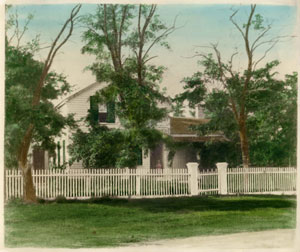 The Dyer house (left), located on State Street across from where Lincoln School was later built, sheltered many a traveller, with scarcely a day passing, according to his memoirs, without a person -- often several persons -- stopping for a meal or lodging. Hospitality was a leading trait of Western life -- Wisconsin then being considered a part of the western frontier.
The Dyer house (left), located on State Street across from where Lincoln School was later built, sheltered many a traveller, with scarcely a day passing, according to his memoirs, without a person -- often several persons -- stopping for a meal or lodging. Hospitality was a leading trait of Western life -- Wisconsin then being considered a part of the western frontier.
According to daughter Harriet, her earliest recollections were of cousins of my father's and second cousins dropping in from Vermont to see the West, and spending the winter or summer as might be, to the great discontent of my Aunt Julia (Mrs. Origen Perkins, who lived next door) and my Father, who found it extremely difficult to entertain them in their pioneer homes in Burlington. Usually the guests were people whom they had never seen nor heard of, who were sons and daughters of my grandfather's Uncle Samuel, Uncle Benjamin, or Uncle what not, who complimented Aunt Julia's and Mother's cooking with gusto and the remark "The Dyers always like good cooking." I can recall how my eyes bulged and "auribus erectis" (my ears perked up) over these remarks, and how Mother followed me to the gate when I went to school with the menacing whisper "Never, never repeat what cousin Adeline says."
The early settlers -- as many of us sometimes forget -- did not have all the amenities and conveniences that we enjoy and expect today. Even doctors had to attend to the ordinary tasks of daily life. At an Old Timers banquet in 1912, Francis Reuschlein told of first coming to Burlington in 1852, arriving at night. He said
I got up next morning and went out into the street to take a look at Burlington by day light. Behold, as I looked down the street there stood a cow, and beside the cow sat a man wearing a stove pipe hat milking the cow. I was afterwards told it was Dr. Dyer. As I looked on the other side of the street there stood another cow with a stove pipe sitting beside it; this was Mr. Lyon (William Penn Lyon) who was afterwards Judge Lyon, chief justice of the Wisconsin supreme court.
The Dyer house was not only the stopping place for relatives and other travellers, but was also one of the several houses and farms in and around Burlington that provided shelter to freedom-seeking runaway slaves in the years of the Underground Railroad, when harboring fugitive slaves was a federal crime. At the original dedication of this monument on the Lincoln School grounds in 1935, Dr. Dyer's granddaughter, Mabel Norton, said that the Dyer house had sheltered three fugitive slaves, on their separate journeys to Canada and freedom.
Recounting one incident, Miss Norton said that "It was suggested to my mother (Harriet) that she play outdoors but, scenting some mystery, she crept up the stairs which led to the attic. All she could make out were two terrified eyes peering through the dusky shadows. With a piercing cry, she fled down the stairs to the cheerful glow of the lamplight and the refuge of her mother's arms. She was not allowed to return to school for several days and until the fugitive was well on his way to safety and freedom. She added that one of the fugitives had to be led back south into Illinois in order to throw the pursuing U.S. marshall off the trail.
According to Miss Norton, all three fugitives, in later years, retraced the steps of their journeys and stopped to thank Grandfather -- Dr. Dyer -- for his share in their rescue.
Those three were not the only freedom-seekers Dr. Dyer had a hand in helping. And his participation in abolitionist and Underground Railroad activities was not a spur-of-the-moment decision.
In one of his letters, Dr. Dyer thanked a friend for a copy of the latter's "Martyrdom of Lovejoy," an account of abolitionist publisher Elijah P. Lovejoy being murdered by a mob in Alton, Illinois. He went on,
"I almost feel like claiming kinship with every one of those early pioneers in the cause of human liberty. I too was a humble worker in this great reformation. I know something of the scoffs and jeers heaped upon the early Abolitionists. I experienced a little share of them in my own person. From the moment I read of the death in 1837 of Elijah P. Lovejoy, and the clamor of that infuriated mob for his blood, I became a radical Abolitionist. My children were reared in an anti-slavery climate. I moved into Wisconsin in 1839, when it was a territory. In the census report made by the then Territorial Marshall, Gen. James, he enumerated something like a dozen slaves, designating them as slaves, male and female, with their ages. I wrote a communication, occupying a couple of columns in the Cincinnati Philanthropist, enclosing the Marshall's report. It was copied by the New York Tribune then being started by Horace Greeley. I believe that I was the first person who called public attention to the subject of slavery in Wisconsin." (We remember here that the Northwest Ordinance banned slavery in the entire Northwest Territory, which included Wisconsin.)
In 1840, Dr. Dyer was called upon to deliver a July 4th address at Delavan. In that speech, which was delivered to about 100 people and printed about a month later in the Southport Telegraph (Southport then being the name of Kenosha), Dr. Dyer talked on the two great moral questions of that time -- temperance and slavery. After discussing the temperance question, he turned to slavery, pointing out its evils and how it pitted one part of the nation against the other. Possibly anticipating the war that would be fought some 20 years later, Dr. Dyer called slavery "a source of danger to the stability of our republican institutions" and said that "in a republican government, liberty and slavery cannot long dwell together." He asked, "What then is our duty as patriots, as philanthropists and as lovers of liberty? Which side shall we be on? Surely we will be for liberty."
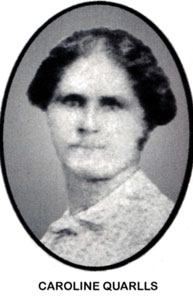
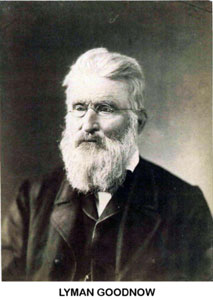 Just a couple of years later, in 1842, Dr. Dyer became involved in Caroline Quarlls' journey to freedom. 16-year-old Caroline had run away from her mistress in St. Louis and made her way to Milwaukee where she was befriended by a barber, who was also a former slave. When she was warned that he had betrayed her, however, she hid under a wooden container, variously described as a sugar hogshead or a crockery cask, during a hot August day until she was taken to the Waukesha-Pewaukee area. When her pursuers closed in on her there, she was brought by Lyman Goodnow to the Spring Prairie area adjoining Burlington, where she was sheltered on several farms. It was at one of these farms, probably the Puffer farm on Highway 11 west of Burlington in the valley near what was later called Lightfield's hill, that Dr. Dyer, who was visiting at a nearby farm, heard that a fugitive was being hidden and insisted on meeting her. In recounting Caroline's story many years later, Goodnow said that as he was talking to 4 or 5 men at the Arms brothers farm on what to do, along came Dr. Dyer, who
Just a couple of years later, in 1842, Dr. Dyer became involved in Caroline Quarlls' journey to freedom. 16-year-old Caroline had run away from her mistress in St. Louis and made her way to Milwaukee where she was befriended by a barber, who was also a former slave. When she was warned that he had betrayed her, however, she hid under a wooden container, variously described as a sugar hogshead or a crockery cask, during a hot August day until she was taken to the Waukesha-Pewaukee area. When her pursuers closed in on her there, she was brought by Lyman Goodnow to the Spring Prairie area adjoining Burlington, where she was sheltered on several farms. It was at one of these farms, probably the Puffer farm on Highway 11 west of Burlington in the valley near what was later called Lightfield's hill, that Dr. Dyer, who was visiting at a nearby farm, heard that a fugitive was being hidden and insisted on meeting her. In recounting Caroline's story many years later, Goodnow said that as he was talking to 4 or 5 men at the Arms brothers farm on what to do, along came Dr. Dyer, who
"proved to be the Commander-in-chief (a strong Abolitionist, the greatest and best friend to humanity. We could not keep the Doctor from seeing the girl; so we all went down to where she was, and held another consultation, when it was decided I should take Mr. Chenery's buggy and harness, and continue the journey to safety and freedom. Dr. Dyer went home and made preparations. He came back with a pillow-case full of cakes, pies and cheese, to be used in case of an emergency. He inquired into my finances. I told him what I had (which was about 8 dollars). He commanded the friends to draw their wallets, and he took up enough to make $20 with what I had. The Doctor gave me a recommendation, the best I ever read, and an appeal to friends of humanity to assist me without question to the extent of my asking. I believe there never was an appeal like that written by mortal man before or since. It would almost stir the heart of a stone."
Goodnow said that when night came on, he and Caroline departed on a 3-week journey by horse and buggy took them through Illinois, Indiana, and Michigan, to Detroit, where they were taken by boat across the Detroit River to Sandwich, Ontario, Canada. After crossing the river, Caroline began crying, and clutched Goodnow by the arm, asking if it was possible that she was being taken back to St. Louis. Goodnow said he "talked and explained, but it took some time to clear her mind, that side of the river appearing to her like the country across from St. Louis."
Caroline later married Allen Watkins, who had also escaped to Canada. Many of their descendants still live in the Sandwich and Detroit areas, including one who lives in the house in Sandwich where Caroline and her family lived. The street on which the house is located has since been named Watkins Street.
Dr. Dyer was also one of the founding members of the Burlington Baptist Society, established in 1843 by several Burlington residents who had previously belonged to the Spring Prairie Baptist church. As an article of their constitution, the Burlington Baptists stated that no one would be admitted to membership who believed in or practiced slavery or the use of intoxicating liquors.
Daughter Harriet said that her father was a Garrisonian anti-slavery man, who helped run the Underground Railroad. She recalled hearing her father reading aloud his letter to The Liberator (the newspaper published by abolitionist William Lloyd Garrison) calling attention to the fact that a U.S. Army officer by the name of Jefferson Davis, a West Point graduate who was assigned to Fort Snelling in Minnesota, "was transporting with his family 1 body servant - a negro slave - and desiring to know if that was constitutional, which greatly excited W. L. G (Garrison)."
Dr. Dyer was one of organizers of the "Burlington Liberty Association" in 1844; and was also a stockholder in and agent of the American Freeman, an abolitionist newspaper published first in "Milwaukie" and then in Prairieville (now Waukesha). When Chauncey C. Olin of the Freeman, who several years later was to conduct fugitive Joshua Glover on a part of his journey to freedom, brought a former slave, who called himself Lewis Washington, on a speaking tour of southeastern Wisconsin in 1847, it was Dr. Dyer who had a meeting called at the old brick school house -- now known as Whitman School -- which then sat near the corner of Dodge and Madison Streets, just a couple of blocks from Dr. Dyer's home. Dr. Dyer, according to Olin, made it a point to say to everybody that they must turn out in force, so as to give encouragement to the speaker, Lewis Washington, because he was a colored man and once a slave. Olin said that before the meeting ended, a collection was taken for the speaker and quite a good sum was added to his purse, and that the American Freeman also gained a good many subscriptions.
Although we haven't found any mention of Dr. Dyer's being at a lecture that Frederick Douglass, the African-American orator and former slave, gave in Burlington in 1866 on the assassination of President Lincoln, who would doubt that Dr. Dyer failed to attend, particularly since it was held at the Baptist church building (today the Church of the Nazarene) just a block up Jefferson Street from the Burlington Historical Museum.
Dr. Dyer was also a delegate to the 1848 Liberty Party Convention in Buffalo, New York, and he was a Republican member of the 1858 Wisconsin State Assembly. The Republican Party had been formed in 1854 as the anti-slavery party.
Dr. Dyer also made a lasting mark on the community, as a physician. Rev. Carl Stackman, speaking at the 1935 dedication, said that when a physician comes to a community, the people learn to measure him, not only for his medical skill and knowledge, but as a man whose character is revealed in sympathy and service. From all that we can learn, said Rev. Stackman, Dr. Dyer seems to have embodied all that was highest and best in the traditions of his profession, which has given so generously to human welfare, and both as a man and as a physician he commanded everywhere the love and affection and trust of the people he served. In a day when travel was largely on horseback over the rough roads and hidden trails, and when the drug store was for the most part carried in the doctor's saddlebags, Dr. Dyer went day and night, untiringly on his errands of service and helpfulness, for fees that were ridiculously low and often paid in produce of the farm.
Interesting stories are told of him, according to Stackman, such as that of his being roused out of bed one night by the call of a farmer who had come to Dr. Dyer's house seeking immediate help for his wife several miles away. Putting his head out of the window, Dr. Dyer asked in no amiable tone, "Who's there?" The knocker said, "It's Steve Houghton, come out and see my wife, she's awful bad. Come soon as you can, for God's sake." The doctor said, "I can't, Steve, just back from a hard jaunt, can't turn out for another long drive tonight. Get some other doctor, I won't go." And down went the window.
Houghton, in his perplexity, thought of Caleb P. Barns. He would get Barns to go and use his influence a second time with the doctor. So another sound sleeper was aroused, another window raised: "What's wanted?" "O, Barns, go with me to Dyer's; see if you can't persuade him to go out to my poor wife, he's always attended her, no other doctor will do." Mr. Barns, knowing the doctor's characteristics better than Houghton, said, "Get into your wagon, Steve, and drive home as fast as you can. You'll do well if you get there first." Houghton acted on the advice and found the doctor ahead of him.
In memoirs written for his children, Dr. Dyer paid special tribute to his beloved Eliza in her role as a doctor's wife. He said
"I was gone much of the time during the sickly seasons, often getting home when my wife and children were asleep in bed, at all hours of the night. Early in the morning your Mother would quietly arise, so as not to disturb me; make a fire in the stove, put on the tea kettle, and take the milk pail on her arm, go to the yard by the way of the barn, to first give the horse his oats to be ready for me. After milking 2 cows, she would wash and dress the children, and then call me. By the time I was ready, the breakfast was also ready. I ate hastily, went out and saddled my horse, throwing the old pill bags across the saddle, to begin again another day's ride. This was our daily life during the whole sickly seasons."
Dr. Dyer's body might be weary but his spirit was indomitable, and where there was need for his service, his spirit ruled. Such was the character of the man whom the entire community came to love and trust as he ministered to them for nearly 50 years.
